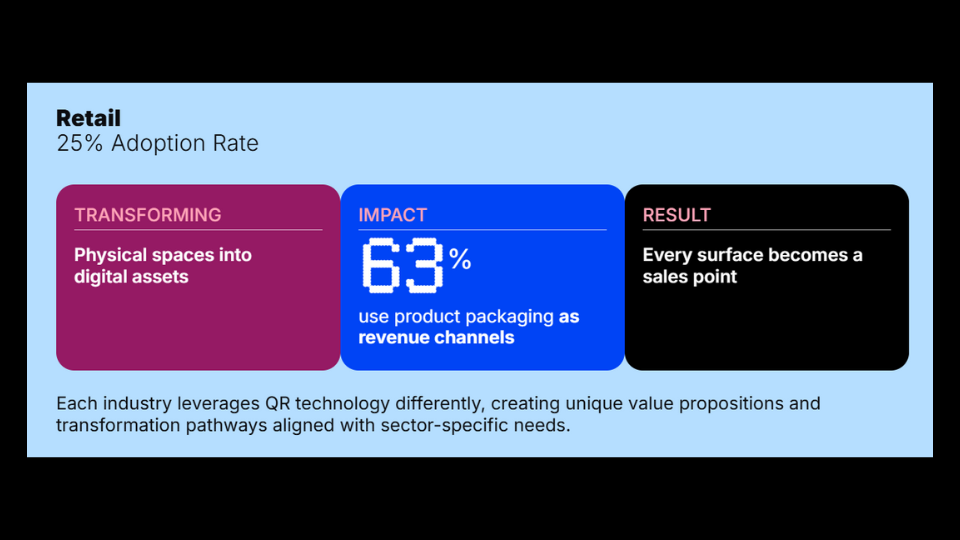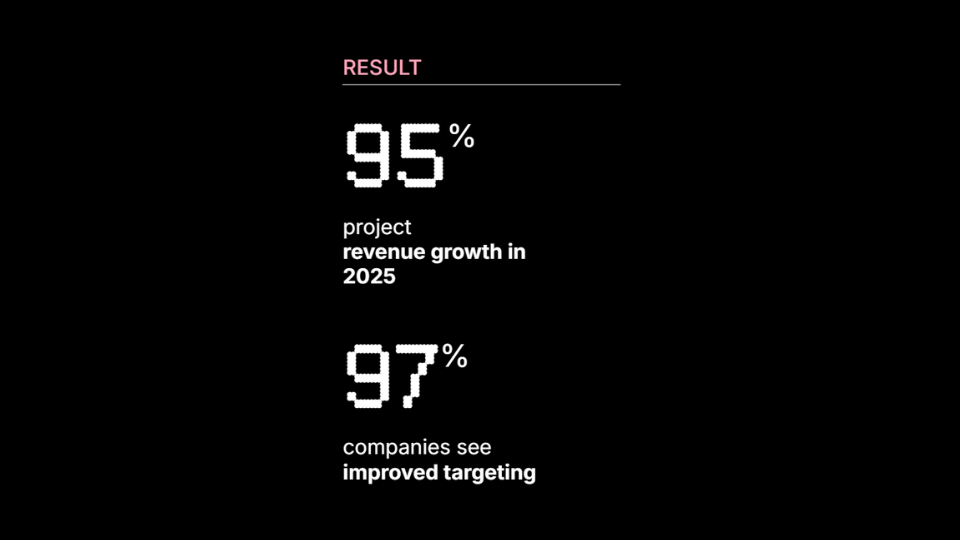A Snapshot of QR Codes in 2025

QR Codes used to be that thing you only noticed when you needed a menu. You’d squint, scan, and move on. But fast-forward to 2025, and they’ve come a long way from lonely corners of restaurant tables.
Today, QR Codes are portals connecting you to richer digital experiences. They automate entire business workflows and help brands collect real-time data through just one scan.
These once-simple tools are now everywhere, but just how significant has this growth been?
Uniqode’s State of QR Codes 2025 report looks at how businesses can use them to better connect with customers and improve every step of their journey.
One thing is clear: QR Codes deserve a real spot in your strategy. Their impact is growing fast, and we’re just getting started.
Scanning QR Codes is becoming a daily habit
You’ve probably noticed it yourself. QR Codes are now on posters, packaging, receipts, storefronts, and even bathroom doors. More importantly, people are actually scanning them.
According to the report, 9 in 10 consumers engage with QR Codes at least once a week, and over half scan them daily.
With QR Code scanning becoming a reflex, people are using it to do things that actually matter to them. This includes tracking deliveries, watching how-to videos, verifying a product’s authenticity, or even jumping straight into a customer support chat.
What started during the pandemic as a contactless workaround has turned into a habit powered by speed, ease, and trust. No more broken links and dead ends. And the value? More than anyone imagined.
For companies, QR Codes are no longer just data tools, but a way to personalize customer journeys at scale using features like QR Code-driven analytics to collect first-party data such as scan time, location, device, and campaign context.
A QR Code isn’t a nice-to-have anymore. It is a business necessity.
QR Codes have moved from marketing campaigns to core systems
Businesses are scaling their use of QR Codes far beyond marketing to how they operate.
In manufacturing, 18% of companies have adopted QR Codes to digitize supply chains.
Among them, 43% report improvements in logistics tracking using QR Codes. Other benefits of using QR Codes include improved inventory management, shipment tracking, and operational efficiency.
And it doesn’t stop there, in retail, 25% of businesses have adopted QR Codes to transform physical spaces into digital assets, making everything from storefronts to product displays interactive.

So, why are more businesses adopting QR Codes?
Because they:
- Reduce friction in the customer journey
- Cut costs and save paper
- Collect valuable first-party data
- Bridge the gap between physical and digital experiences
- Require no new hardware or complex installations — just a scan, and it works
As more businesses lean in, they're also getting smarter about which kind of QR Codes to use.
Static QR Codes are fading out
Most consumers don’t think twice about what kind of QR Code they scan, but the difference between static and dynamic QR Codes is a big deal for businesses.
Static QR Codes are set in stone, mostly for one-time use. You can’t change where they lead, and you can’t see how they’re performing. That might’ve been fine initially, but it's a limitation for most use cases today.
Dynamic QR Codes, on the other hand, are built for change. You can update links, track scans, and use that data to improve the experience.
According to Uniqode’s report, 79% of businesses have adopted dynamic QR Codes, resulting in better targeting and revenue growth. That’s not just a trend, it's a shift in how teams think about flexibility and control.
Especially for brands running campaigns across different locations or experimenting with different offers, being able to tweak things on the fly without reprinting materials is a huge win.
What does this mean? Static QR Codes just don’t keep up. Businesses want something they can learn from, iterate on, and scale up. Dynamic QR Code makes that possible.

QR data is now a first-party goldmine
With cookies on the way out and privacy rules getting tighter, brands are scrambling for clean, consent-based data. QR Codes can give you just that.
When someone scans a QR Code, you can learn when they scanned, what city they were in, what device they used, and which campaign brought them there. You don’t need to chase third-party trackers. You’re getting data straight from the interaction.
And it’s not just about gathering numbers, but using them for context. If someone scans a code on your sneaker product packaging at 8 AM on a Monday, they’re telling you something about their behavior. Multiply that by hundreds or thousands of scans, and you start to see patterns—what content works, what time gets the most engagement, what regions respond better to certain offers.
In fact, 49% of businesses are collecting first-party data from over 10,000 customer interactions, and 95% of businesses now use QR-based analytics to gather first-party data. You don’t have to keep guessing what people want. You now have the data to shape future campaigns and offers and fine-tune their messaging.
What’s next: Smarter, safer, and more sustainable QR Codes
QR Codes are evolving fast, and the next wave isn’t just about better engagement for businesses but also changing how things work in the real world.
One shift that’s already taking shape is the blend of QR and AR. Scan a code on a sneaker box, and you’re no longer taken to a basic product page. You’re watching a 3D animation, trying on shoes virtually, or seeing how it looks in your space. These shifts mark only the beginning of the next wave of QR Code innovation, where personalization, AR, and automation redefine customer engagement.
According to this State of QR Codes report, over 90% of enterprise leaders believe QR-driven augmented reality will become a standard part of customer experiences. It’s immersive, practical, and also removes the guesswork from buying.
The second big move is identity. QR Codes are being used for secure logins, employee badges, visitor passes, and even as digital ID tags linked to blockchain systems. They’re fast, personal, and a whole lot more scalable than printing cards or relying on physical keys.
And then there’s the environmental side. Companies are under pressure to cut waste. QR Codes offer a clear alternative to printed manuals, brochures, product inserts, and receipts. Nearly 9 in 10 businesses see QR Codes as key to driving sustainability, particularly by reducing packaging waste and shifting printed content to digital formats. Less printing, shipping, and clutter.
But while the future is promising, it’s not without pitfalls.
One weak spot is the scan experience itself. If a QR Code leads to a broken page, a confusing layout, or content that doesn’t load well on mobile, users won’t give it a second chance. That’s why brands must focus on building stronger post-scan experiences that make every scan feel purposeful and rewarding A single scan is all you get to prove it works.
The other issue is trust. Just like phishing links in emails, scammers use fake QR Codes to trick people into visiting harmful websites or sharing personal information. That’s why it matters where your codes are generated and how they’re secured. Using a verified, enterprise-grade QR Code platform like Uniqode promises security for your users.
The opportunity is clear, but so is the responsibility. If you’re inviting people into a digital experience with a simple scan, the least you can do is make it secure, smooth, and worth their time.
Your QR Code strategy roadmap
You don’t need to run a big company to make QR Codes work for you. Honestly, most people using them today aren’t. It could be someone running a food stall, a designer sharing their portfolio, or a small team trying to speed up customer support.
Here’s how you can use QR Codes without overcomplicating anything:
- Use dynamic QR Codes: Like we’ve mentioned, static codes are a dead end. With dynamic ones, you can update the destination link without reprinting or redesigning anything. That means fewer mistakes, more flexibility, and less waste.
- Put them where people need them: A QR Code on your product tag? Smart. One hidden on the back of your terms and conditions? Not so much. Add QR Codes where they make sense, such as packaging, invoices, business cards, posters, or anywhere people might want to take the next step quickly.
- Track what gets scanned: Most QR Code platforms like Uniqode let you see when, where, and how often your code is scanned. Use that information to figure out what’s actually working and tweak the experience based on real behavior.
- Match it to your brand: QR Codes don’t have to be plain or boring. Add your brand colors, drop in your logo, and ensure it looks good on different surfaces. A code that feels like part of your brand builds trust at a glance.
- Let people know what’s behind the code: People hesitate when they don’t know what to expect. A small note like “Watch a 30-second demo” or “Get 10% off” tells them exactly why it’s worth scanning. Be clear and give them no surprises. This manages their expectations.
Create your QR Code for free here!
Scanning is just the start
QR Codes aren’t flashy. You know them to be small, square, and often overlooked. But in 2025, they’re doing a lot of heavy lifting—bridging the offline and online, powering payments, delivering content, replacing paper, and quietly collecting the kind of data marketers used to dream about.
This new QR-driven reality? It’s not hype. It’s where we are now. People expect the scan to work, and businesses are building strategies around that expectation.
Want to see how it’s all unfolding? What do the numbers say? How are companies using QR Codes, and what’s coming next? Uniqode’s State of QR Codes 2025 report is worth a deeper look.
